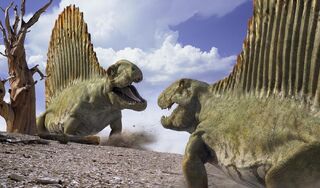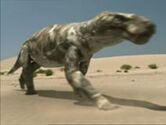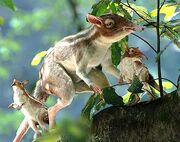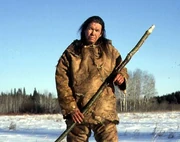| This article is under construction. |
| This article is currently under construction by a user. To avoid edit clashes, please do not edit until this template has been removed. |
Mammals are a class of vertebrate animals whose females are characterized by the possession of mammary glands while both males and females are characterized by sweat glands, hair, three middle ear bones used in hearing, a neocortex region in the brain, and one bone in the lower jaw.
The evoloution of Synapsids[]
The first mammal ansestors were the pelycosaurs. The pelycosaurs were mammal-like reptiles and had different types of teeth and had the synapsid opening in the back of their skull. The pelycosaurs gave rise to the therapsids - the next group of mammal ancestors. The therapsids also were mammal-like reptiles. But they developed a more erect stance and the three middle ear bones. The therapsids gave rise to the cynodonts - the final stage before modern mammals. The cynodonts were also mammal-like reptiles but they had fur, hhad whiskers and a moist nose. But they layed eggs, a tail that swayed while it walked and was a reptile like the pelycosaurs and therapsids. The cynodonts were a lot like todays montremes (Platypus and Echidna species). The cynodonts were nearly like Archaeopteryx that it is a missing link between reptiles and mammals just as Archaeopteryx is for Dinosaurs and Birds. The main difference is that Birds belongs to Dinosaurs (some scientists call Dinosaurs for their own group of animals), while Mammals are their own group and Cynodonts belongs to Mammal-like Reptiles.

Dimetrodon, a primitive synapsid.

A Gorgonopsid, an advanced synapsid (a therapsid).
Thrinaxodon a cynodont. The group who gave rise to the modern day mammals
The evolution of Mammals[]
Mammals appeared back in the early Mesozoic Era as demonstrated first by the proto-mammal Thrinaxodon (WWD ep 1). It was already furried, had whiskers and a moist nose, but still laid eggs and didn't have any milk glands. Those traits are shared by the modern monotremes of Australia. (Except for the noses.)
The next step was depicted by Steropodon (WWD ep 5), Alphadon (WWD 3:D) and Didelphodon (WWD ep 6) - they were marsupials and carried their

Alphadon, a maursupial.
offspring in pouches. Though initially small and secretive creatures, they began to thrive at the end of the dinosaurs' rein and the arrival of the K/T extinction event helped them to become the dominant group of animals on Earth, as shown in the last episode of WWD, where Didelphodon and similar mammals are common fixtures of the dinosaurs' world, and they are not particularly small nor secretive.
The Cenozoic Era saw many lines of mammals rise and fall. Walking with Beasts had

Leptictidium, a primitive mammal.
shown several of them, from the small Leptictidium in ep 1 to the mighty mammoth in ep 6. Some of them have even colonized the oceans (ep 2). Humans, which appeared at the end of the Cenozoic, in the Pleistocene Epoch, are mammals too. During that period many lineages of mammals disappeared, including the multituberculates, more ancient mammals like Leptictidium, and the ancient whales such as Basilosaurus. As a rule such species had primitive brains, and it were the more intelligent

A Human. a type of placental mammal
species, such as Australopithecus, who continued to survive and evolved inot humans. Nowadays humans are the most intelligent of mammals, and they rule the world.
